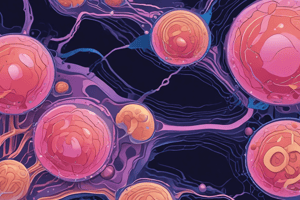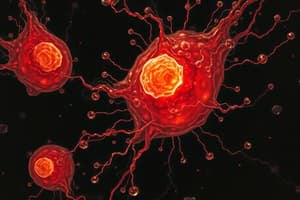Podcast
Questions and Answers
What is the significance of neoangiogenesis in tumor growth?
What is the significance of neoangiogenesis in tumor growth?
- It reduces the oxygen supply to the tumor.
- It enables the tumor to secrete pro-apoptotic factors.
- It provides necessary nutrients and oxygen to the tumor. (correct)
- It prevents tumor cells from entering the vascular system.
Which pro-angiogenic cytokine is primarily involved in stimulating neoangiogenesis?
Which pro-angiogenic cytokine is primarily involved in stimulating neoangiogenesis?
- TNF-alpha
- VEGF (correct)
- IL-6
- IFN-gamma
What role does E-cadherin play in epithelial tumor cells?
What role does E-cadherin play in epithelial tumor cells?
- It promotes cell dissociation for metastasis.
- It enhances adhesion between tumor cells. (correct)
- It degrades the extracellular matrix.
- It activates pro-angiogenic cytokines.
What is a major challenge in the metastatic process of cancer?
What is a major challenge in the metastatic process of cancer?
What is the benefit of leaky and dilated new vessels formed during neoangiogenesis?
What is the benefit of leaky and dilated new vessels formed during neoangiogenesis?
What role does Bcl2 play in the context of apoptosis?
What role does Bcl2 play in the context of apoptosis?
Which cellular process is primarily disrupted to allow cancer to develop through evasion of apoptosis?
Which cellular process is primarily disrupted to allow cancer to develop through evasion of apoptosis?
In which specific genetic alteration is Bcl2 overexpressed leading to follicular lymphoma?
In which specific genetic alteration is Bcl2 overexpressed leading to follicular lymphoma?
What typically occurs to B-cells during somatic hypermutation in lymph nodes?
What typically occurs to B-cells during somatic hypermutation in lymph nodes?
Which of the following is NOT a cause of ER stress that can affect apoptosis?
Which of the following is NOT a cause of ER stress that can affect apoptosis?
What is a factor that does NOT influence the site of distant metastasis?
What is a factor that does NOT influence the site of distant metastasis?
Which characteristic is LEAST associated with malignant tumors?
Which characteristic is LEAST associated with malignant tumors?
Which of the following phenomena is directly connected to the invasive capabilities of tumors?
Which of the following phenomena is directly connected to the invasive capabilities of tumors?
What process occurs after epithelial-to-mesenchymal transition (EMT) in metastatic tumor outgrowth?
What process occurs after epithelial-to-mesenchymal transition (EMT) in metastatic tumor outgrowth?
Which of the following is NOT a method cancer cells use to protect themselves during metastasis?
Which of the following is NOT a method cancer cells use to protect themselves during metastasis?
Which pathway is primarily responsible for the transmission of growth signals to the nucleus?
Which pathway is primarily responsible for the transmission of growth signals to the nucleus?
What characterizes an oncogene in relation to proto-oncogenes?
What characterizes an oncogene in relation to proto-oncogenes?
What effect do loss-of-function mutations in tumor suppressor genes have on cell proliferation?
What effect do loss-of-function mutations in tumor suppressor genes have on cell proliferation?
Which of the following best describes the role of APC in the context of growth signaling?
Which of the following best describes the role of APC in the context of growth signaling?
Which statement is true regarding growth factor receptor oncogenes?
Which statement is true regarding growth factor receptor oncogenes?
How do signal transduction pathways contribute to cellular functions?
How do signal transduction pathways contribute to cellular functions?
What is a primary consequence of oncogenes acquiring gain-of-function mutations?
What is a primary consequence of oncogenes acquiring gain-of-function mutations?
Which factor is primarily altered in cells affected by mutated proto-oncogenes?
Which factor is primarily altered in cells affected by mutated proto-oncogenes?
What is a common metabolic abnormality associated with malignancy?
What is a common metabolic abnormality associated with malignancy?
Which cytokine increases hepcidin production, resulting in iron-deficiency anemia in cancer patients?
Which cytokine increases hepcidin production, resulting in iron-deficiency anemia in cancer patients?
What condition is characterized by a chronic inflammatory reaction due to infiltrating cancers?
What condition is characterized by a chronic inflammatory reaction due to infiltrating cancers?
Which of the following is NOT a potential mechanism contributing to hypercoagulability in cancer?
Which of the following is NOT a potential mechanism contributing to hypercoagulability in cancer?
Acromegaly may develop as a result of which of the following tumor types?
Acromegaly may develop as a result of which of the following tumor types?
What clinical phenomenon may occur as a result of neoplasm presence, not due to physical obstruction?
What clinical phenomenon may occur as a result of neoplasm presence, not due to physical obstruction?
What is the primary cause of anemia in cancer patients?
What is the primary cause of anemia in cancer patients?
What condition can occur in response to esophageal squamous cell carcinoma?
What condition can occur in response to esophageal squamous cell carcinoma?
Which tumor type is most frequently associated with non-bacterial thrombotic endocarditis?
Which tumor type is most frequently associated with non-bacterial thrombotic endocarditis?
Which symptom is commonly associated with cancer cachexia?
Which symptom is commonly associated with cancer cachexia?
What can result from direct invasion of a vessel wall by rectal adenocarcinoma?
What can result from direct invasion of a vessel wall by rectal adenocarcinoma?
Which syndrome may present with rapid appearance of multiple seborrheic keratoses?
Which syndrome may present with rapid appearance of multiple seborrheic keratoses?
Which of the following is least likely to be associated with respiratory failure due to tumor effects?
Which of the following is least likely to be associated with respiratory failure due to tumor effects?
Flashcards are hidden until you start studying
Study Notes
Ability to Invade and Metastasize
- Ability to invade and metastasize is a major feature of cancer, contributing to morbidity and mortality.
- The process of metastasis is highly inefficient, with less than 0.01% of circulating tumor cells successfully forming metastases
- This process involves a complicated interplay between cancer cells and the surrounding normal stroma.
- Cancer cells must detach from their original location, break through the basement membrane, and travel to distant sites.
- They may also need to evade the immune system and find a suitable environment to proliferate and develop into a secondary tumor.
Key Characteristics of Cancer Cells
- Self-sufficiency in growth signals: Normal cells require growth factors to stimulate division. Cancer cells can produce their own growth factors or have mutations that constantly activate growth-promoting pathways, making them independent of external signals.
- Insensitivity to growth inhibition: Normal cells have mechanisms to stop uncontrolled growth. Cancer cells often have mutations in tumor suppressor genes that normally act as "brakes" on cell division, leading to uncontrolled growth.
- Evasion of apoptosis: Apoptosis is a natural process of programmed cell death that eliminates damaged or unwanted cells. Cancer cells can evade apoptosis, preventing their elimination and allowing them to survive and multiply.
- Sustained angiogenesis: Tumors require a blood supply to grow and spread. Cancer cells can stimulate angiogenesis, the formation of new blood vessels, which provides them with oxygen, nutrients, and a route for metastasis.
- Ability to invade and metastasize: Cancer cells can detach from the original tumor, invade surrounding tissues, and spread to other parts of the body.
Mechanisms of Invasion and Metastasis
- Epithelial-to-mesenchymal transition (EMT): Epithelial cells, which normally form tight junctions, can undergo a transition to become mesenchymal cells with a more migratory and invasive phenotype. This process can be triggered by changes in gene expression, as well as by interactions with the surrounding environment.
Clinical Features of Neoplasia
- Benign tumors: Generally slower growing, well-defined, and encapsulated. They often remain localized and are usually not life-threatening.
- Malignant tumors: Typically grow more rapidly, invade surrounding tissues, and can metastasize to distant sites.
Location of Tumors and Clinical Effects
- The location of a tumor is critical in determining its clinical effects (morbidity and mortality).
- Tumors in vital organs or near critical structures can cause life-threatening complications.
Cancer Cachexia
- Progressive loss of body fat and lean body mass, often associated with advanced cancer.
- Mechanisms include elevated metabolic rate, systemic inflammation, and anorexia.
Cancer and Anemia
- Can cause anemia through various mechanisms, including:
- Iron deficiency: Increased hepcidin production due to inflammation in the body can reduce iron absorption and utilization.
- Reduced erythropoietin production: Inflammation can also limit the production of erythropoietin, a hormone that stimulates red blood cell production.
- Blood loss: Hemorrhage or hemolysis (destruction of red blood cells) can contribute to anemia.
Cancer and Hypercoagulability
- Can cause an increased risk of blood clots (thrombosis and embolism) due to factors like:
- Tumor cell production of tissue factor: A molecule that promotes blood clotting.
- Increased platelet activation: Platelets become more active and prone to forming clots.
- Vascular compression and invasion: Cancer cells can compress and invade blood vessels, leading to obstructions or blood clots.
Hypercalcemia of Malignancy
- A common metabolic abnormality in cancer patients where the serum calcium level is elevated.
- Two general mechanisms:
- Osteolysis: Cancer cells can directly destroy bone tissue, releasing calcium into the bloodstream.
- Production of calcemic humoral substances: Some cancers produce factors like parathyroid hormone-related protein (PTHRP) which increases serum calcium levels.
Hormonal Effects of Neoplasms
- Endocrine tumors (benign or malignant) can produce hormones, which can result in a variety of clinical effects.
Functional Pituitary Adenomas
- Somatotroph adenomas are a common type of functional pituitary adenoma. They produce excess growth hormone, leading to:
- Gigantism: If the tumor occurs before growth plate closure in children, resulting in excessive height and disproportionate long limbs.
- Acromegaly: If the tumor occurs after growth plate closure, resulting in enlarged facial features, hands, and feet.
Paraneoplastic Syndromes
- Disease states that occur as a result of the presence of a tumor, but are not directly related to the tumor's location.
- Can occur in up to 10% of cancer patients.
- Can be the first sign of a hidden (occult) cancer.
- Can be mistaken as metastatic disease.
- Can cause significant clinical problems and even death.
Studying That Suits You
Use AI to generate personalized quizzes and flashcards to suit your learning preferences.





